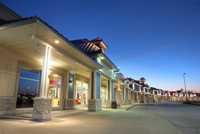Technology, Tenant Health and Well-Being, and New Construction Explored at Annual Conference

Trends in retail and mixed-use properties were the focus of the Chicagoland 14th Annual Asset, Property, and Facility Management Conferences organized by RE Journal, with two panels exploring this topic from the perspective of the property managers and asset managers in the trenches.
Trends in retail and mixed-use properties were the focus of the Chicagoland 14th Annual Asset, Property, and Facility Management Conferences organized by RE Journal, with two panels exploring this topic from the perspective of the property managers and asset managers in the trenches.
The opening panel addressed the state of the retail and mixed-used market. When asked what type of cost-effective strategies property managers can implement to increase the value of the property, several suggestions were put forth, with technology being the clear winner as the best way to increase the net operating income (NOI) of a property. Some of the features specifically mentioned to increase included: optimized HVAC systems, managed electricity reductions, maximized building security, smart sensors for lighting, and controlled appliances from remote locations—all of which have the end result of lowering energy usage and therefore utility costs.
The panel was also asked how commercial buildings can foster tenants’ health and well-being in the workplace. Adding an on-site fitness center stood out, with panelists commenting on the qualitative and quantitative benefits of physical activity and how it provides life balance, longevity, health, and work productivity. Other initiatives the panelists have implemented include sit-stand desks, guided yoga classes and stress management seminars.
The idea of a nap room also came up. While sleeping on the job was once considered taboo, today, more and more companies are encouraging employees to take a mid-shift snooze, noted the panelists. Studies have shown that 29 percent of workers report falling asleep or becoming very sleepy at work, and a lack of sleep costs $63 billion each year in lost productivity. But a short twenty-minute nap can boost alertness and improve performance.
Other proposals to improve health and well-being shared with attendees included wine tasting events, meditation classes, or any activities that can get workers away from their workspaces for a little while.
The second part of the conference focused on current building designs and construction trends. Specifically, the panel addressed common caveats for new and nearly new construction. For example, many on the panel expressed that they have experienced ventilation and exhaust issues. They communicated how such problems affect both the public areas of a building and individual apartments. In common areas, a proper ventilation system may not exist at all or may not function properly.
New high-rise constructions present a particular problem for ventilation and exhaust systems. These buildings are well sealed from the outside, and when their heating systems are in use, hot air rises through the hallways and creates negative pressure, pulling odors from one apartment to another, usually on the lower floors. This kind of problem can be a real challenge to alleviate.
Other obstacles faced by property managers face originate at the start of the builder/developer stage and could be overcome with management involvement. Some of the top physical problems with new residential construction are insufficient coating on the roof and incorrectly-sized boilers that are too weak for the building’s needs. In addition, having too few elevators installed in a building likewise can be a problem in some new structures. Soundproofing, either inadequate soundproofing or soundproofing that was improperly installed between floors and walls, also was identified as a common concern.
These conditions notwithstanding, air and water leaks from roofs, terraces and windows were cited as the single biggest complaint in newly constructed residential buildings. A few of the panelists noted that sometimes in these structures, architectural details are not as they were sold to be. The developer or contractor did not complete the job correctly, omitting some items or substituting one element for another of lesser quality or lower design standard. These then become challenges for the property management team to address as residents move into the building and complaints arise.
About the Author
Ted Thurn is director of government affairs at IREM Headquarters in Chicago.